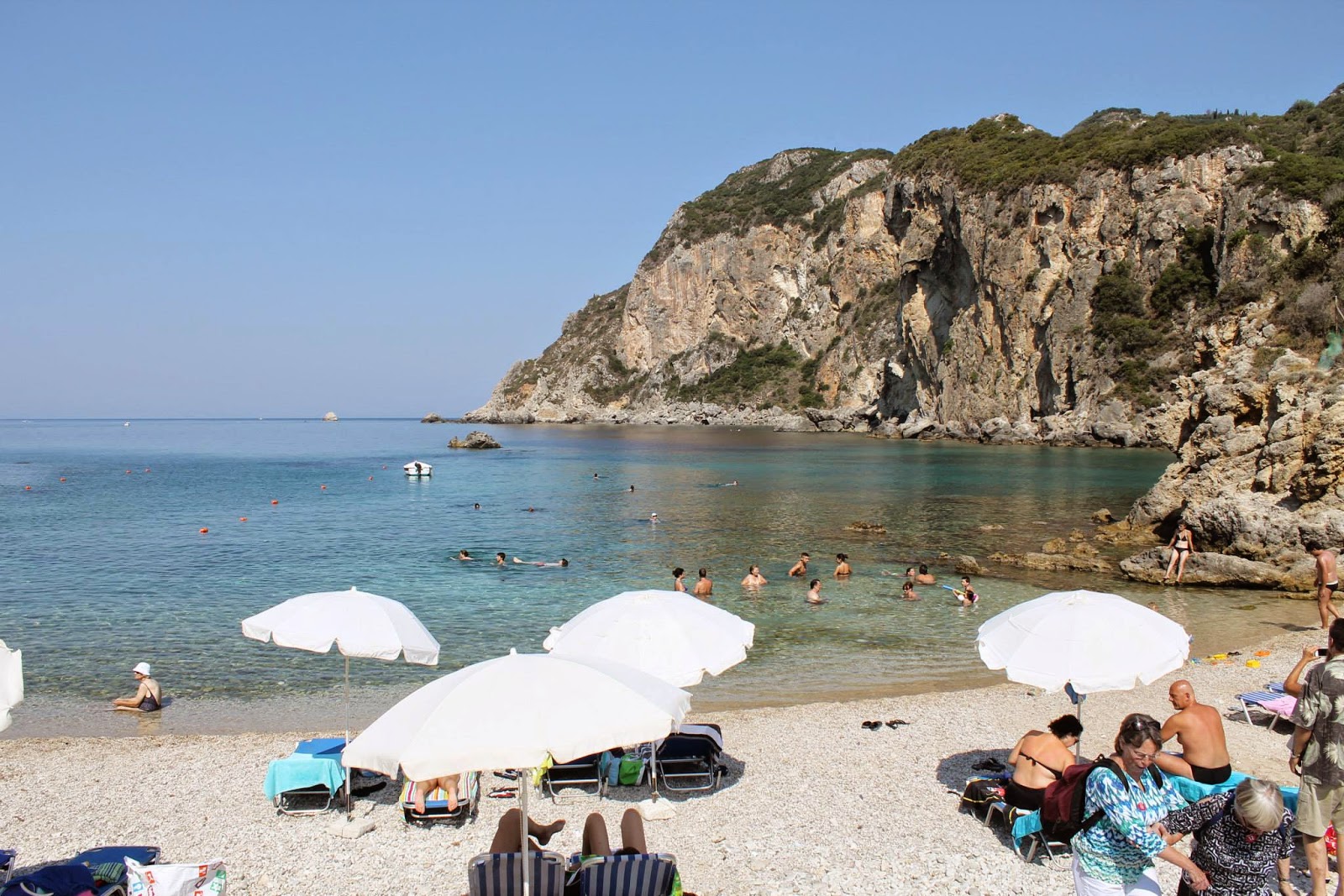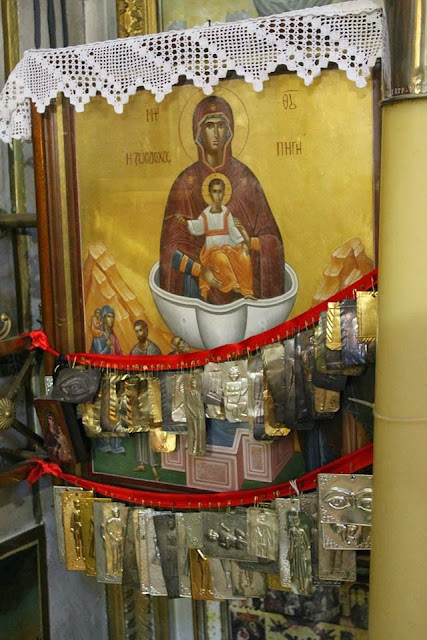Corfu is the second largest Ionian island, roughly shaped like an upper-case Σ (sigma), which is fitting for a Greek isle. It's hard to write anything about 'a day in Corfu' that sums the essence of such a big island. However, if you focus your visit on beaches, forts and monasteries, I think you'll have as much success as can be had. The mythical Jason and Odysseus also visited here by boat, and Hercules figures in local legend. All three tarried here with beautiful women before there were the forts or monasteries, so the island has that going for it.
 |
| A typical view of the rugged coastline from the monastery at Paleokastritsa. |
Clocks were set forward an hour last night, so my son Tom was especially difficult to wake up this morning. As if on cue, once we were in the ship's theater waiting to debark, several people proved it's possible to stuff up even the simplest instructions, like lining up single file. I wonder how much of the theoretical work on chaos theory was inspired by cruise ship passenger behavior.
Our tour bus first took a quick spin around the old city of Corfu (Kerkira) and its fortifications before heading to our main destination on the west side of the island, about forty minutes away. In a few places we passed lions carved in the Renaissance-era fortress walls, a reminder that Corfu was once Venetian territory and a bulwark against the Ottoman Turks. Views along the rugged, limestone coastline are superb. The road across the island's spine to Paleokastritsa is steep and winding, with many switchbacks. One unfortunate young woman couldn't handle the motion, so we stopped for a minute for her to recollect outside and return to the bus a little lighter. She had to exchange seats, and for the latter half of the ride I was particularly happy the motor coach was air conditioned.
 |
| Monastery of the Virgin Mary Mother of Life. Open for business since 1278. |
Our first stop was the hilltop Monastery of the Virgin Mary Mother of Life, attached to a cliff-top Greek Orthodox Church, sitting amongst cypress trees and overlooking the southern Adriatic Sea since 1278. The extreme heatwave meant the monks relaxed the monastery dress code and permitted shorts, but I noticed several teenage girls were asked to put on a scratchy, pullover woolen skirt and/or a shawl if their shoulders were bare. The local staff had boxes of the things on hand. I think in some cases the young ladies' attire liberally pushed the definition of "shorts" and "shirt." They may observe the requirement for modest dress next time they visit a Greek Orthodox church, because those loaner skirts looked to largely be made of hair unwashed since the Apostles. Boys with death metal t-shirts were exempt.
I'd never been in an Orthodox Church before, so the tour was particularly interesting, and I especially liked the icons. But the church was small, and regular cycles of tour groups precluded much meditative thought. An elderly local woman was evidently in charge of maintaining some decorum inside, largely through icy stares at the most egregious chatterboxes, and I'm sure she daily weighed peace against the economic benefits of a fleet of tourists. Her victims continued, blithely unaware.
 |
| A reminder that this peaceful setting was in a strategic piece of geography through history. |
Well-tended gardens of citrus and olive trees surround the place, and most of the pathways on the upper level are overhung with grapes. We tried a few, and they were good. Views down to the water were superlative. Thomas was more interested in the cats, and he burned half a memory card in photos. The guide said there were nine monks and fifty cats. Her information was out of date; we spotted at least four brand new squatters.
 |
| The cat to monk ratio was recently skewed. |
At the monastery I bought a small bottle of kumquat liqueur that the island is known for, in the sickle shape of Corfu. Princess Cruise Line's port brochure says "the koum kouat only grows in Corfu." That may come as a surprise to the Chinese. I also feel compelled to document I had a potted tree in Wembley Downs, Western Australia, and I made several nice jars of kumquat marmalade so the fruit didn't go to waste. Liars.
Afterwards, we drove downhill for the obligatory shopping stop in Paleokastritsa and to overlook the beaches there. Every cruise ship excursion has some sort of kickback detour. We didn't buy anything as usual, but the coastline is a spectacular setting of rugged grottoes and recessed bays of sparkling blue water sheltered between ribs of limestone. The seaside was dotted with yachts ranging up to the presumptuous, indicating the "other half" were vacationing within a stone's throw. The rich and famous--they're just like us!
 |
| One of the beaches near the village of Paleokastritsa. |
Our swimming beach was a little more pedestrian, but still a nice setting about twenty minutes drive south. We were at one of the most popular spots in Corfu, on the northwest end of Glyfada beach.
There were a couple rickety, damp-floored changing shacks reminiscent of outhouses. I chose one already occupied by a wet, discolored undergarment--I avoided touching any walls in the confined space and yearned for disinfectant. The beach is a mixture of slabby bedrock, cobbles and a wide stretch of dark golden sand, which was extremely hot on the soles of our feet. There was no gentle amble to the strand, only a mad dance like a walk-across-hot-coals gone wrong. The need for disinfectant passed. A few feet into the water, and the rocks give way completely to sand, and a gentle gradient that allowed me to walk far out beyond the shoreline, though I kept an eye on my distant camera bag. The water was crystal clear. After a dip in the Ionian sea, we recrossed the burning gauntlet then lounged poolside for a couple hours. Dad and I had a local "Mythos" beer while Thomas had a Coke. He kept the glass bottle since he'd never had a cola in glass before and the labeling was in Greek. That doesn't make the ingredients any more difficult to pronounce.
 |
| Glyfada beach. |
 |
| Dad walking gingerly around the rocky part of Glyfada beach. A few meters further out and it graded to fine sand underfoot. |
 |
| Mythos in some other beer's glass... |
From our balcony vantage, we watched a group of well-oiled young people prepare for a beach volleyball game. This mostly involved male courtship displays and brief scuffles for dominance. Only one relatively scrawny youth appeared to be doing much to advance the competition, hosing down the dark sand for about an hour. He was getting a hard lesson in social Darwinism. When the game finally began, there was little volleying but much flexing.
When time to go, the motor coach could not drive all the way down to the beach, so we had a hot five minute walk uphill. We were short a couple of loafers at the top of course, so the poor guide had to walk back, scour the reconnoiter area for strays and climb back with the perpetrators, whose excuse was "We're not so good with time." Neither are monkeys, but maybe we haven't all evolved so much beyond them.
Upon return to Kerkira, we again passed through the old city and its influences of former Venetian, French and British occupiers. There was even a cricket pitch in the central square. The British should really stop exporting sports for other countries to beat them in.
 |
The official name is St Mark (San Marco); the common name is New Fortress. It was completed in 1645 by the
Venetians and subsequently occupied and modified by the French and then the British.
|
 |
| Begun in the 6th Century, the Old Fortress was originally built on a peninsula east of the town. Construction lasted for centuries. The Venetians dug a moat turning the fortress into an island. |
In our third game of chess since boarding the Ruby Princess, Thomas pulled out a stalemate against me for the first time ever, despite my considerable advantage (two queens). We may need to quit playing.
Next stop, Olympia.











.JPG)

2 comments:
What a great shore excursion. It looks like you were able to see quite a bit and experience culture, history and even some beach time. I have been looking at the Greek islands itinerary on Princess (our go-to cruise line) and would love to go. In the meantime, thanks for the detailed virtual tour that's very inspiring.
Thank you Mary. Because of the itinerary, it was a place I was largely thinking to "get through" on the way to other destinations. As always in this case, I found there was a lot more to offer, and I was only getting a taste (and a good one). I really liked Princess, especially compared to Carnival (though they are both under the same umbrella!). The Greek islands are a wonderful place for a family to visit.
Post a Comment